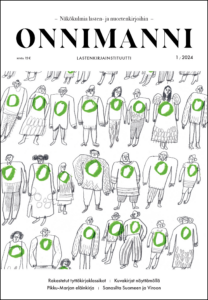
Many of the articles and interviews in this year’s first issue of Onnimanni accentuate the appeal of nostalgia.
For the first time, Lucy M. Montgomery’s classic girls’ book Emily of New Moon (1923) has been published in an unabridged Finnish translation (Runotyttö, Art House 2023). I. K. Inha’s translation from 1928, which was slightly revised in the 1960s, has been replaced by Kaisa Ranta’s new translation. Laura Leden, who has studied the translation of classic girls’ books in her dissertation, has interviewed Ranta about her translation strategies. The new translation takes, for example, into consideration the broad target audience of the one hundred year old original, and addresses both younger and older readers. Anna Pölkki’s article enters into dialogue with Leden’s interview. According to Pölkki, abridged translations and adaptations that take into consideration child readers ought to be available alongside the new unabridged translation.
Lately, three classic girls’ books – L. M. Montgomery’s Anne of Green Gables, Louisa M. Alcott’s Little Women and Frances Hodgson Burnett’s The Secret Garden – have been dramatized and staged. This phenomenon can in part be explained by our uncertain times, in which many adults find comfort in reading experiences from their childhood and youth. Accompanied by her daughter, Sanna Kivimäki saw the play Pikku naisia (Little Women) at Turku City Theatre. They ponder why the story of a mother and her daughters during the American Civil War still is so popular. They conclude that the depiction of inter-generational female relations is timeless and broadly appealing. Yet, they both wish that alongside such classic interpretations, more new and modern narratives that have captured girls would be adapted for the stage.
Also new Finnish picturebooks are often reshaped for the stage. Heli Halme shows how such stage adaptations manage to benefit from the visuality of picturebooks. Halme has interviewed professionals involved in three different theatre productions.
Real children often inspire children’s authors. Laura Latvala and Helga Sjöstedt’s Pikku-Marjan eläinkirja (Little Marja’s Book of Animals) published after the war in 1947, is still the most popular Finnish children’s book in terms of number of copies printed (330 000). Laura Latvala (1921-1986) dedicated the poems in the book to her daughter Marja. Päivi Heikkilä-Halttunen has interviewed Latvala’s recently retired daughter Marja Kiiskinen, who has revealed that she is the girl child who once inspired this book beloved by so many generations of children. At the time of publication, the book was exceptionally modern since the poems about the farm animals and Sjöstedt’s charming illustrations in four colours, subtly taught children the alphabet.
The Estonian children’s author Kairi Look compares the Finnish and Estonian children’s book scenes, looking for differences and similarities. In Estonia, children’s books find their way into the chains of bookstores much more easily than in Finland, whereas Estonians envy the diversity of subjects in Finnish children’s books. As part of the Word Bridge project, authors of children’s and young adult books from Estonia and the region of Pirkanmaa will meet up at a workshop in October in Tartu.
Translation Maria Lassén-Seger
